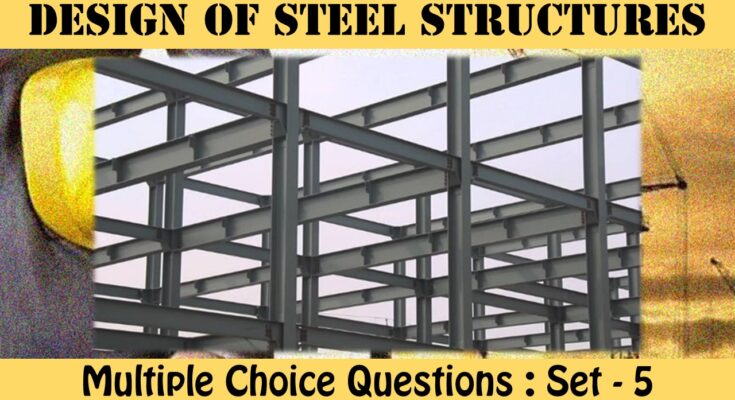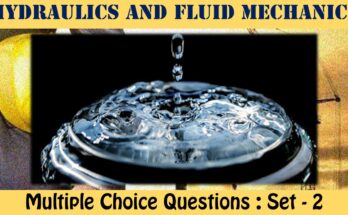MCQ Questions Civil Engineering Design of Steel Structures
The interviewer is almost as nervous as the candidate in most interviews. You might wonder if you look confident enough, if you will hire the right person, or if you are asking the right engineering interview questions. The last question is arguably the most crucial part to worry about when you’re interviewing candidates. Other topics on Civil Engineering Multiple Choice Questions can be accessed
MCQ Questions Civil Engineering Design of Steel Structures - Set - 5
Question 1:
Minimum spacing of vertical stiffeners is limited to
a) d/4
b) d/3
c) d/2
d) 2d/3
where d is the distance between flange angles
Correct Answer – (B)
Question 2 :
The forces acting on the web splice of a plate girder are
a) axial forces
b) shear and axial forces
c) shear and bending forces
d) axial and bending forces
Correct Answer – (C)
Question 3 :
Intermediate vertical stiffeners in a plate girder need be provided if the depth of web exceeds
a) 501
b) 851
c) 200 t
d) 2501
where t is thickness of web
Correct Answer – (B)
Question 4 :
The web crippling due to excessive bearing stress can be avoided by
a) increasing the web thickness
b) providing suitable stiffeners
c) increasing the length of the bearing plates
d) none of the above
Correct Answer – (C)
Question 5 :
Horizontal stiffener in a plate girder is provided to safeguard against
a) shear buckling of web plate
b) compression buckling of web plate
c) yielding
d) all of the above
Correct Answer – (B)
MCQ Questions Civil Engineering Design of Steel Structures
Question 6:
Gantry girders are designed to resist
a) lateral loads
b) longitudinal loads and vertical loads
c) lateral, longitudinal and vertical loads
d) lateral and longitudinal loads
Correct Answer – (C)
Question 7:
Bearing stiffener in a plate girder is used to
a) transfer the load from the top flange to the bottom one
b) prevent buckling of web
c) decrease the effective depth of web
d) prevent excessive deflection
Correct Answer – (B)
Question 8:
As per IS : 800, for compression flange, the outstand of flange plates should not exceed
a) 121
b) 161
c) 201
d) 251
where t = thickness of thinnest flange plate
Correct Answer – (B)
Question 9:
Minimum thickness of web in a plate girder, when the plate is accessible and also exposed to weather, is
a) 5 mm
b) 6 mm
c) 8 mm
d) 10 mm
Correct Answer – (B)
Question 10:
Shear buckling of web in a plate girder is prevented by using
a) vertical intermediate stiffener
b) horizontal stiffener at neutral axis
c) bearing stiffener
d) none of the above
Correct Answer – (A)
- NCERT Solutions Class 12 Mathematics RD Sharma Sets : Exercise 1.1
- NCERT Solutions Class 12 Mathematics RD Sharma Sets : Exercise 1.2
- NCERT Solutions Class 12 Mathematics RD Sharma Sets : Exercise 1.3
- NCERT Solutions Class 12 Mathematics RD Sharma Sets : Exercise 1.4
- NCERT Solutions Class 12 Mathematics RD Sharma Trigonometric Functions : Exercise – 5.1
- NCERT Solutions Class 12 Mathematics RD Sharma Trigonometric Functions : Exercise – 5.2
- NCERT Solutions Class 12 Mathematics RD Sharma Trigonometric Functions : Exercise – 5.3
- NCERT Solutions Class 12 Mathematics RD Sharma Quadratic Equations : Exercise – 14.1
- NCERT Solutions Class 12 Mathematics RD Sharma Quadratic Equations : Exercise – 14.2
- NCERT Solutions Class 12 Mathematics RD Sharma Linear Inequations : Exercise – 15.1
- NCERT Solutions Class 12 Mathematics RD Sharma Linear Inequations : Exercise – 15.2
- NCERT Solutions Class 12 Mathematics RD Sharma Linear Inequations : Exercise – 15.3
- NCERT Solutions Class 12 Mathematics RD Sharma Linear Inequations : Exercise – 15.4
- NCERT Solutions Class 12 Mathematics RD Sharma Linear Inequations : Exercise – 15.5
- NCERT Solutions Class 12 Mathematics RD Sharma Linear Inequations : Exercise – 15.6
Multiple Choice Questions for Competitive Exams
- Multiple Choice Questions Class 12 Chemistry The Solid State
Set -1 Set -2 Set -3 Set -4 Set -5 - MCQ Questions Class 12 Solutions With Answers
Set -1 Set -2 Set -3 Set -4 Set -5 - MCQ Questions Class 12 Electrochemistry With Answers
Set -1 Set -2 Set -3 Set -4 Set -5 - MCQ Questions Class 12 Chemical Kinetics With Answers
Set -1 Set -2 Set -3 Set -4 Set -5 - MCQ Questions Class 12 Surface Chemistry With Answers
Set -1 Set -2 Set -3 Set -4 Set -5 - MCQ Questions Class 12 General Principles and Processes of Isolation of Elements With Answers
Set -1 Set -2 Set -3 Set -4 Set -5




